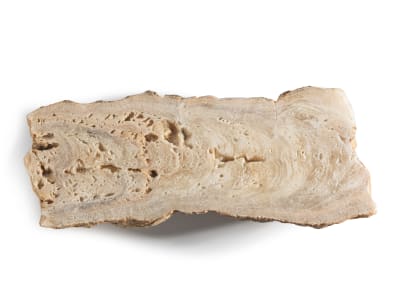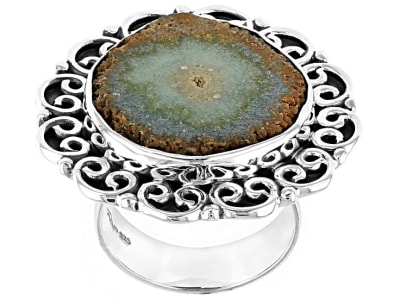Stalactites and stalagmites are types of speleothems or cave formations that are formed by slow deposition of minerals by dripping water. These cave formations are formed when rainwater combines with carbon dioxide to create carbonic acid which then permeates carbonate rocks in the subsurface. The acidic water dissolves carbonate material as it filters through the rock. The dissolved carbonate is carried to caves in the subsurface where the carbon dioxide is released and the water evaporates leaving calcite formations to build up over the millennia. Formations hanging from the cave roof are called stalactites while those that build up from the cave floor are called stalagmites. Sometimes the two will join to form a column. Other carbonates such as azurite and malachite, silicates such as opal and chalcedony, limonite, some sulfides, and other minerals can also be deposited. Stalactites are very fragile, and many US states and countries have laws that prohibit collecting them from caves. Some gem material stalactites have been collected as byproducts during mining. Chrysocolla stalactites have been found in the Pearl Handle Pit, in the Ray Mine, Arizona. The Morenci Mine, also in Arizona, has produced goethite and azurite stalactites. Morocco has produced azurmalachite specimens. Large malachite specimens have come from the L'Etoile du Congo Mine, sometimes called the Star of the Congo Mine, in the Democratic Republic of Congo. Vanadinite stalactites have been found in the Mibladen Mining District, Morocco.
General Information
Stalactite Colors
-
 Black
Black -
 Blue
Blue -
 Brown
Brown -
 Green
Green -
 Multi-color
Multi-color -
 Orange
Orange -
 Red
Red -
 Yellow
Yellow
Countries of Origin
Papua New Guinea; Cambodia; Kazakhstan; Portugal; New Caledonia; Greece; Latvia; Mongolia; Morocco; Unknown; Panama; Guatemala; Iraq; Chile; Nepal; Argentina; Ukraine; Belize; Zambia; Saint Vincent And The Grenadines; India; Canada; Turkey; Belgium; Namibia; Finland; South Africa; Bermuda; Georgia; Jamaica; Peru; Turkmenistan; Venezuela (Bolivarian Republic of); Germany; Tanzania, United Republic Of; Puerto Rico; Viet Nam; Aruba; Madagascar; Thailand; United Kingdom of Great Britain and Northern Ireland; Libya; Sweden; Poland; Bulgaria; Jordan; Nigeria; Tunisia; Croatia; Cook Islands; Sri Lanka; Uruguay; Timor-Leste; Tuvalu; Kenya; Switzerland; Samoa; Spain; Lebanon; Azerbaijan; Cuba; Mauritania; Saint Lucia; Congo (the Democratic Republic of the); Israel; Australia; Myanmar; Cameroon; Gibraltar; Malaysia; Iceland; Oman; Bosnia And Herzegovina; Armenia; Gabon; Austria; El Salvador; Korea (the Republic of); Brazil; Guam; Turks and Caicos Islands; Algeria; Slovenia; Lesotho; Colombia; Ecuador; Iran (Islamic Republic of); Hungary; Republic of Kosovo; Japan; Curacao; Bolivia (Plurinational State of); Lao People's Democratic Republic; Trinidad And Tobago; New Zealand; Vanuatu; Micronesia (Federated States of); Honduras; Italy; Nauru; Ethiopia; Haiti; Macedonia (the former Yugoslav Republic of); Afghanistan; Russian Federation; Czechia; United States of America; Egypt; Malta; South Georgia And The South Sandwich Islands; Pakistan; China; Ireland; Qatar; Slovakia; France; Serbia; Reunion; Romania; Togo; Philippines; Uzbekistan; Barbados; Norway; Botswana; Denmark; Dominican Republic; Mexico; Zimbabwe; Suriname; Indonesia
Care
Most stalactites are Calcite. Calcite is very soft, so be mindful of scratching. It is easily attacked and dissolved by acids such as vinegar. Avoid abrasives, ultrasonic, solvents and heat.

